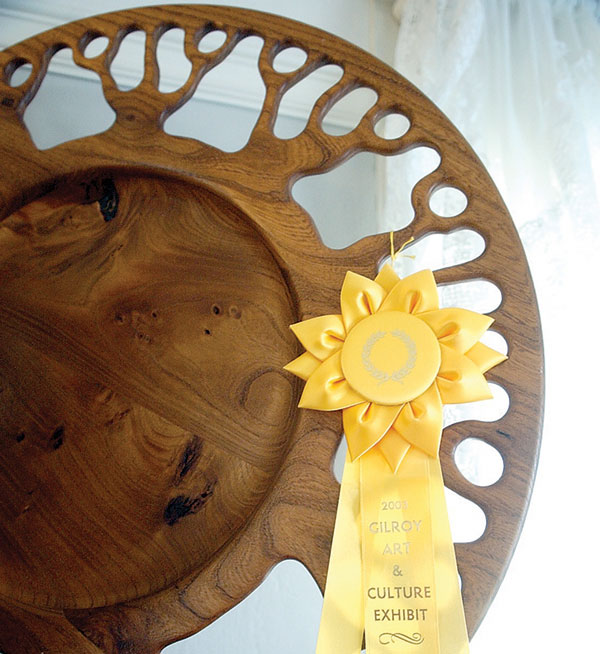
”
I like to go after the ugliest, most gnarled piece of wood I can find,
”
said Don Jensen, reaching for a slick and luminous apricot wood candle holder full of dark, craggy holes.
”
It’s a stump, so it’s probably the most gnarled piece you’re going to get, but just look at the character in that.
”
“I like to go after the ugliest, most gnarled piece of wood I can find,” said Don Jensen, reaching for a slick and luminous apricot wood candle holder full of dark, craggy holes. “It’s a stump, so it’s probably the most gnarled piece you’re going to get, but just look at the character in that.”
Carving stump wood is one of the most difficult tasks Jensen, a wood carver and landscape architect, has taken on because during the process “you lose all control,” he said. The material’s grain shifts at random, and if it’s touched wrong, chunks can go flying.
“Here. See that scratch?” asked Jensen, proudly pointing to a quarter inch-long gouge in the front of his face shield. “A piece of that stump came flying at me, hit square between the eyes. This thing got knocked off. It saved my face.”
Jensen has labeled himself a “wood alchemist,” one who can take a material of middling value and turn it into something extraordinary.
In truth, his years of experience have made him something of a magician, able to turn simple scrap wood into inspired spoons, paddles and salad sets with nothing more than a band saw and an eye for design.
Chips like the one from the apricot stump terrified Jensen when he was younger. He would run from the shop, not to return for a week or more. Now, he said, he just gets even, plying wood to fit his own vision.
Jensen didn’t set off to become an artisan.
He tried woodworking because he needed another merit badge for Boy Scouts and the Florida base his parents were stationed on at the time had a wood shop. Once inside the shop, he found his attraction to the medium immediate and intense.
“Every year for my birthday, I was asking for another tool,” he said. “People wanted to give me shirts or clothes, but I just wanted tools.”
Design is Jensen’s real passion. He dreams up an idea, then finds out what kind of equipment he’ll need to create it, rather than working his ideas around the equipment he already has.
His backyard workshop is littered with boards, blocks and sheets of wood packed tightly onto every shelf and into every corner.
Pull a string hanging from the ceiling and another roomful appears in the attic.
Freshly felled wood takes one year to dry for every inch of thickness, so Jensen’s constantly growing collection, much of which he mills himself from local trees that have died or been felled by storms, is really an investment in the future of his craft.
And it’s more than just Jensen’s dream. It’s a family’s vision brought to fruition.
Jensen’s family came to California from Oklahoma in the depths of the Great Depression, carrying with them large chunks of a walnut tree that had stood by the family farm. It became their Western treasure, one that Jensen tracked down as his expertise grew.
He managed to uncover two boards of the original walnut, which he transformed into the side table that sits in his living room.
Befittingly, more than 50 percent of his work today is in walnut, his wood of choice.
With items priced from $10 to $10,000, including everything from wooden spoons to intricate quilts and one-of-a-kind sculptures made entirely of wood, Jensen hopes those who are seriously interested in his work never feel they need to walk away empty-handed or unsatisfied.
“So many people get stuck on what they see,” said Jensen. “They’re unsure or they don’t want to ask if I can make something with a slightly different style or in a different wood. It’s not going to change the price, they just won’t walk away with it that day because every piece I do is one of a kind.
“Today that is so, so gigantic as opposed to buying a print or a copy (of an art piece). There’s a reason why the prints and copies are so cheap. They’re usually cheaply made from inferior materials.”
For more information on Jensen’s products or to set up an appointment to discuss custom work, including furniture pieces, log on to www.DonJensenDesigns.com or call him at (408) 778-2495. Jensen’s day job also keeps him at home, so he also invites prospective buyers to stop by his workshop at 20 East 5th Street in Morgan Hill, just behind the Morgan Hill Playhouse.









